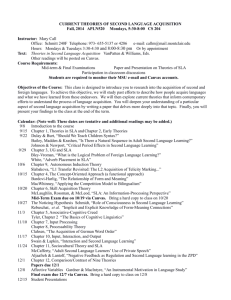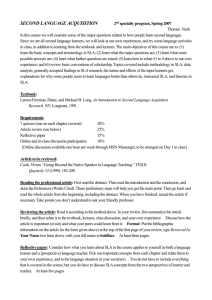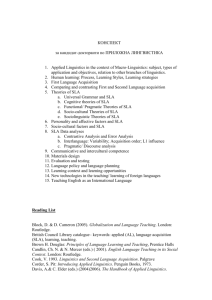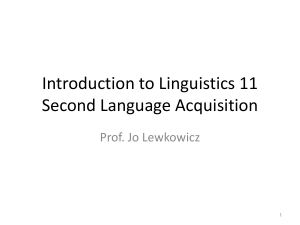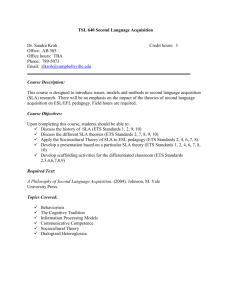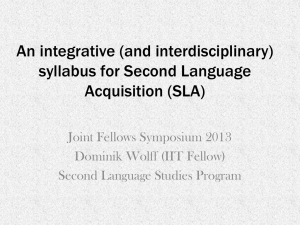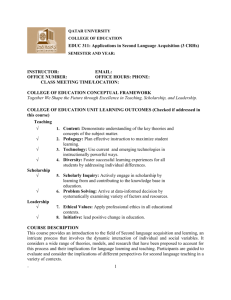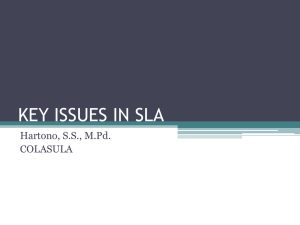Incidental vs intentional learning
advertisement
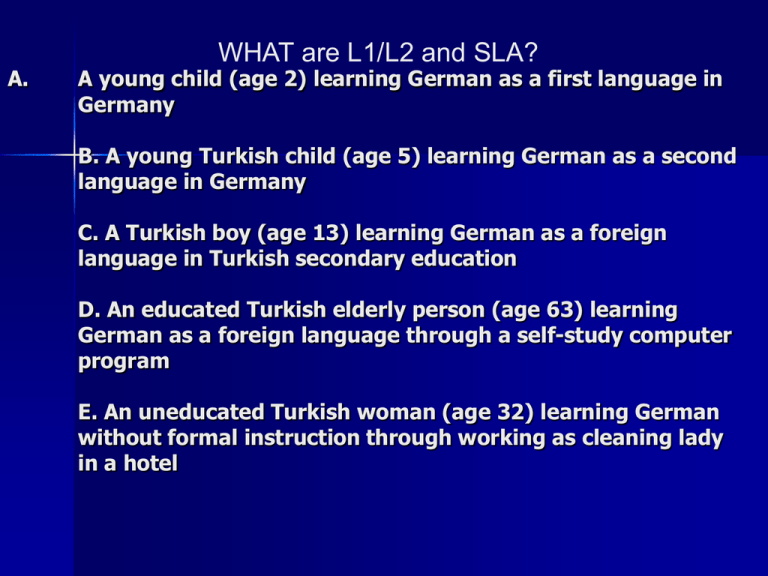
A. WHAT are L1/L2 and SLA? A young child (age 2) learning German as a first language in Germany B. A young Turkish child (age 5) learning German as a second language in Germany C. A Turkish boy (age 13) learning German as a foreign language in Turkish secondary education D. An educated Turkish elderly person (age 63) learning German as a foreign language through a self-study computer program E. An uneducated Turkish woman (age 32) learning German without formal instruction through working as cleaning lady in a hotel Monolingualism/ Bilingualism Grow up in two languages= full command of those languages To show you how difficult it is to define ‘full command’, take a good monolingual dictionary in your first language. Start at page 146 and read the entries. Write down every word you don’t know. How many pages did you turn before you reached 20 unknown words? By counting the total number of words, you can get an idea of the percentage of the total number of words you do and do not know. Monolinguals? Whether Pure monolinguals really exist? - more than one variety of language - more than one dialect - styles First/second and third language How ‘second’ and ‘third’ should be distinguished? – Level of proficiency – The order of the time of acquisition * If you have friends or relatives who have grown up in a setting where more than one language was used, ask them what they consider their first language and why they consider this as their first language. SLA vs FLA SLA:Non-instructed setting= in a aetting in which the language to be learned is spoken in the local community. FLA: formal language instruction= it takes place in a setting in which the language to be learned is not the language spoken in the local community. Acquisition vs Learning Krashen (1983):Subconscious or conscious? Schmidt (1990): instead the term “subconscious”, “without awarenes” : not being aware of having noticed something. For ex: while listening to a tape while sleeping In consciousness research, it is commonly accepted that some level of attention is required to be able to notice something, and that noticing is crucial in obtaining new information or uptake. Acquisition and Learning? ‘subconscious’:the inability to explain what one knows. In other words, learners may use language forms correctly without being able to say exactly why the forms are the way they are. acquisition is seen as a natural process of growth of knowledge and skills in a language without a level of metaknowledge about the language learning is seen as an artificial process in which the ‘rules’ of a language are focussed on. learning the rules could not lead to an automatic use of language as in acquisition (the automat,zat,on of rules) Input vs Intake(uptake) ‘Input’ is everything around us we may perceive with our senses, ‘uptake’ or ‘intake’ is what we pay attention to and notice. Some level of attention is required to be able to notice something, and that noticing is crucial in obtaining new information. – Needs and interests for noticing: We may not be interested in the colour of our neighbour’s eyes, but for someone else, or even for ourselves at another moment in time. – input is the main source of information for learning but not all input becomes intake, which is necessary for learning instruction may have an awareness-raising effect, increasing the likelihood of noticing features in input through the establishment of expectation and comprehending. For intake, at least some minimal level of processing needs to take place. There must be some awareness of new information that is relevant for the learning system to incorporate. Intake may refer to information that strengthens existing knowledge, or it may fill a gap in knowledge that was noticed by the learner before. Listen to a news broadcast in one of your foreign languages. Try to understand what is said, but also monitor yourself while listening.What do you do: are you listening in a similar manner all the time or are you going through waves of noise and understanding? Do you notice when the input becomes intake? implicit vs explicit learninig * unconscious operation * - IMPLICIT LEARNING: a process that takes place naturally, simply and without conscious operations. -Explicit learning:a more conscious operation where the individual makes and tests hypotheses in a search for structure. Incidental vs intentional learning An example: intentional learning is learning words from a bilingual list in a decontextualised manner Learning words by reading and inferring meanings from context is usually seen as incidental learning. Incidental vs intentional learning For example, when a person reads for pleasure and doesn’t bother to look up a word he or she doesn’t know in a dictionary, but a few pages later realises what that word means, then incidental learning is said to have taken place. If a teacher instructs a student to take a text and read it and find out the meanings of unknown words, then it becomes an intentional learning activity. Instructed versus noninstructed SLA In many settings, acquisition takes place through a mix of instructed and non-instructed learning. some languages are learned mainly through education. For example, when a person learns English in Turkey, there is little chance for him to meet British people and find a British setting in which he can pick up the language. His main source of contact and input is the institute or school, but he may also ‘pick up’ some of the language through reading on his own. Instructed versus noninstructed SLA some languages are learned mainly through informal interaction. Many migrants throughout the world move into a setting in which they have to learn the local language on their own in order to survive. In many such settings there is no formal system of education to learn that language, so people have to pick up the language from what they hear and see in their environment. Instructed versus non-instructed SLA The English language is typically a language that is acquired in a setting in which there is a combination of instructed and noninstructed SLA. An example of such a situation is Norway, where English is taught at school and English is very prominently present in many parts of society. There are many Englishlanguage programmes on TV, computer software is only partly available in Norwegian, and in higher education, industry and trade English is emerging as the dominant language. Instructed versus noninstructed SLA TASK indicate what percentage of your English you have acquired through school,through the media (TV, radio, computer) or through other sources.
